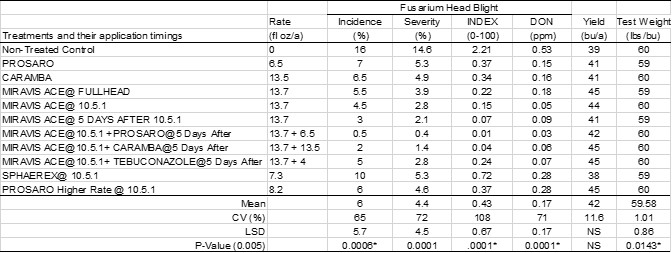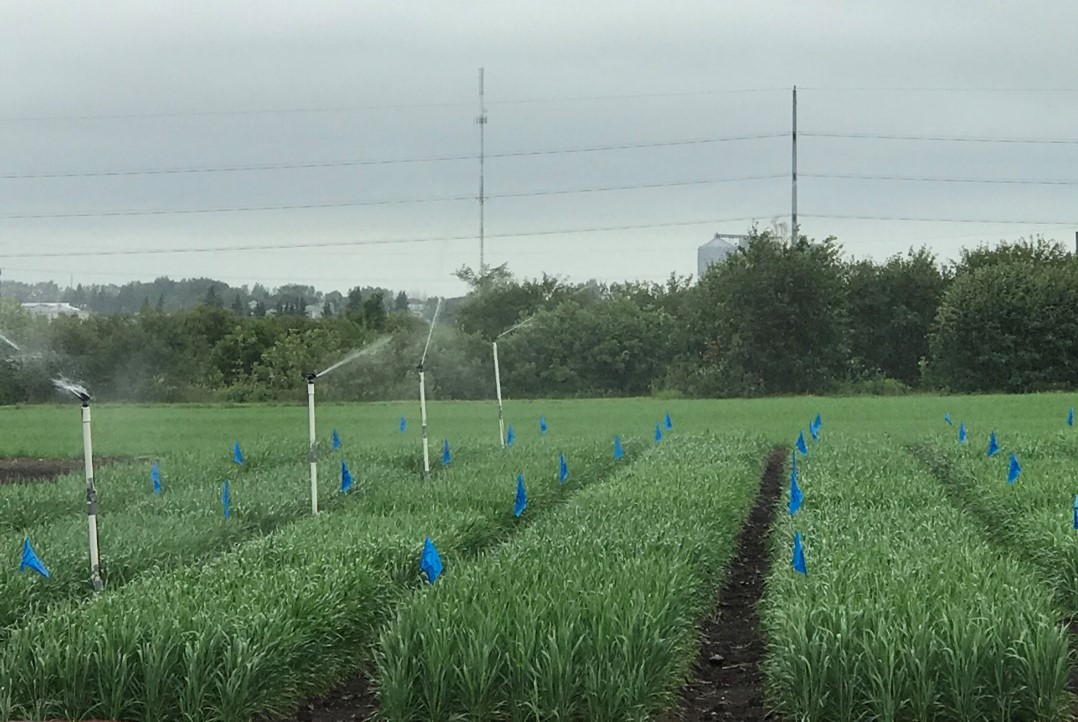Objective: To evaluate the efficacy of fungicides at different application timings to manage Fusarium head blight (FHB) in Hard Red Spring Wheat (HRSW).
Methods:
Location: NDSU Langdon Research Extension Center
Experimental design: Randomized complete block, replicated four times.
Previous crop: Canola
Cultivars of HRSW tested: WB Mayville
Planting: 1.5 million pure live seeds/acre planted on May 4, 2021. A border plot was planted between treated plots to minimize interference from spray drift.
Plot size: Seven rows at six inch spacing, 5 ft. x 20 ft., mowed back to 5 ft. x 16 ft.
Herbicides applied: Wide Match (1.33 pt/a) + Axial Bold (15 fl oz/a) + 2, 4-D Amine (1 pt/a) applied on June 4, 2021.
Inoculation: Plots were inoculated by spreading corn spawn inoculum at the approximate boot stage (Feekes 9-10) at the rate of 300 g/plot.
Disease development: Supplemental moisture was provided by running overhead irrigation from boot to soft dough stage at the rate of one hour per day to create a conducive environment for FHB development.
Fungicide treatments: Fungicides were applied with a CO2-pressurized backpack sprayer with a three nozzle boom (XR-8002) and water volume at 20 GPA. Fungicide (Miravis Ace) application was made at full head emergence on June 25. Miravis Ace, Prosaro, Sphaerex and Caramba were applied at 10% flowering (anthesis or 10.5.1 stage) on June 30 and 5 days after anthesis sprays were done on July 5. Refer to Table 1 for the treatments, rates and application timings.
Disease assessment: FHB incidence was obtained on 50 random heads showing FHB symptoms at hard dough stage. FHB head severity was rated using 0 -100% scale on 50 random heads, excluding two outer rows. FHB index (Index) was calculated using formula: Index = (SEV*INC)/100.
Harvest: Plots were harvested on September 2 with a small plot combine and the yield was determined at 13.5% moisture.
Data analysis: Statistical analysis was done using Agrobase Generation II software. Fisher’s least significant difference (LSD) was used to compare means at p (α = 0.05).
Results: There were significant differences found between the non-treated check and the fungicide applied treatments at different timings among the variables tested except yield. However, there were no significant differences found among the application timings or the fungicides tested (Table 1).
Table 1: Efficacy of fungicides at various application timings to manage Fusarium Head Blight on Hard Red Spring Wheat.

